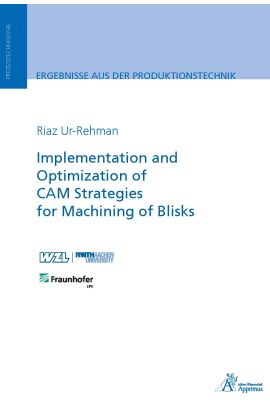The objectives of developing light weight aero engines for achieving sustainable and economical aviation are meet by using blisks with smaller diameter, reduced blade pitch; and airfoils that have longer profile sections and are more curved, twisted and bowed. All this complexity of design is a challenge for manufacturers and at the end effect the task to be handled by an expert manufacturing process planner. The current practice in process planning will never cope with the increasing number of blisk designs and higher volume for their production. The need to innovate the system of manufacturing process planning which makes possible to produce large number of blisks in diverse shapes at lower cost is intense. The requirement to bring innovation approaches into manufacturing planning of blisk has been realized; accordingly, in the thesis the methods that handle this complexity in design and provide meaningful data and information to develop an effective process plan are discussed and demonstrated.
The research tasks of this thesis targets this difficult situation by analyzing the current situation in blisk development and defining methods for the evaluation of blisk geometry in order to determine early during blisk design and development, the most suitable process conditions. The defined method is specified and evaluated through a graphic model in analogy to blisk channel and afterwards its implementation into a computer solution is used for testing and evaluation of real blisk geometries. The analysis of current situation in blisk development also indicates that most cost during production is involved in manufacturing blisk channel. Milling process is most widely used process for manufacturing blisk channel. Accordingly, blisk channel and milling process are the two defined boundaries to carry out the research tasks during the thesis.
The research task of the thesis has achieved three types of results: knowledge gained about the challenges in the manufacturing of blisk arising due to innovations in its design that are necessary to achieve the objectives of sustainable aviation, techniques developed for improved planning for manufacturing through the analyze of blisk geometry that determines the total volume of material to be machined and material remaining after roughing and finish machining (before the detailed process planning could start), and design and development of software tools to further automate the process planning for manufacturing blisks. The reading of thesis will elaborate upon the approaches used to achieve these results.
| Autor | Ur-Rehman, Riaz |
|---|---|
| Lieferzeit | 3-4 Tage |
| Gewicht | 0.278 kg |
| Erscheinungsdatum | 27.09.2018 |
Prozesstechnologie
Implementation and Optimization of CAM Strategies for Machining of Blisks
Kurzbeschreibung
Blisks with smaller diameter, reduced blade pitch; and airfoils that are longer, more curved, twisted and bowed are essential for developing aero engines with lower specific fuel consumption. All this complexity of design is a challenge for manufacturers and at the end effect the task to be handled by an expert manufacturing process planner. The current practice in process planning will never cope with the increasing complexity in blisk designs and higher volumes for their production. The requirement to develop innovative approaches for manufacturing planning of blisks has been realized; accordingly, in the thesis the methods that handle this complexity in design and provide meaningful data and information to develop effective process plans are discussed and demonstrated.

